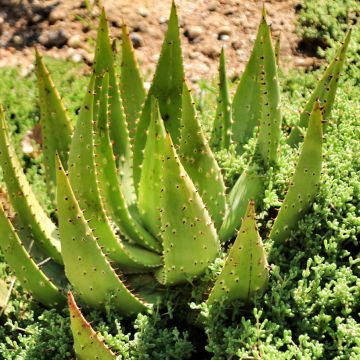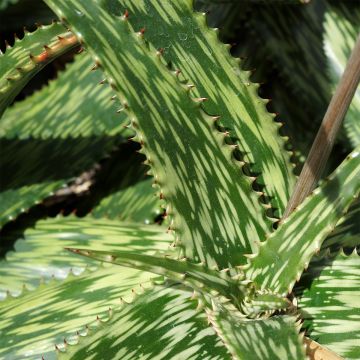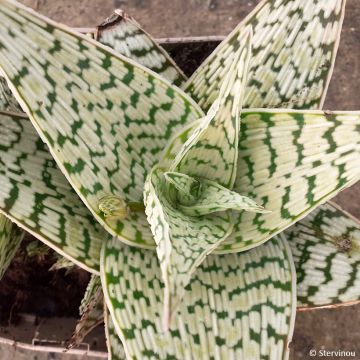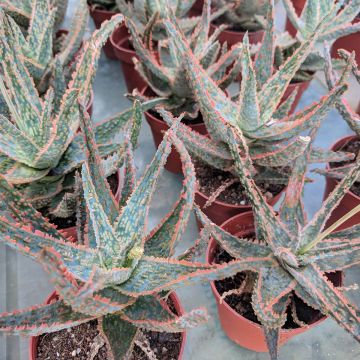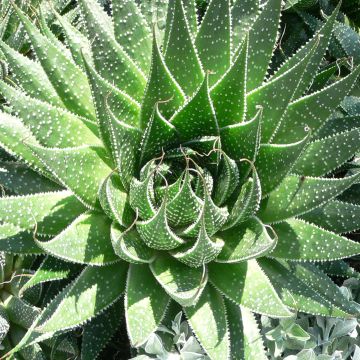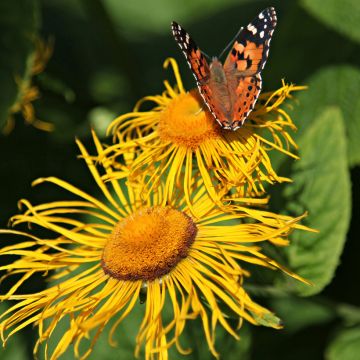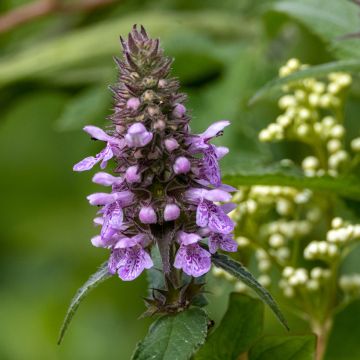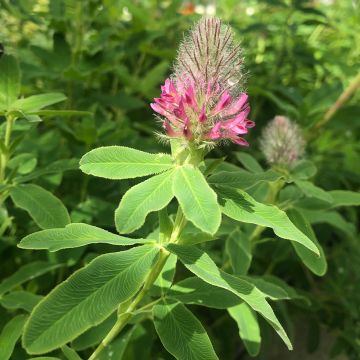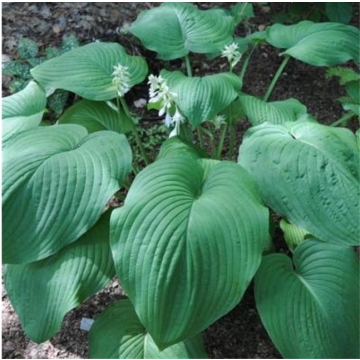

Aloe perfoliata (mitriformis)
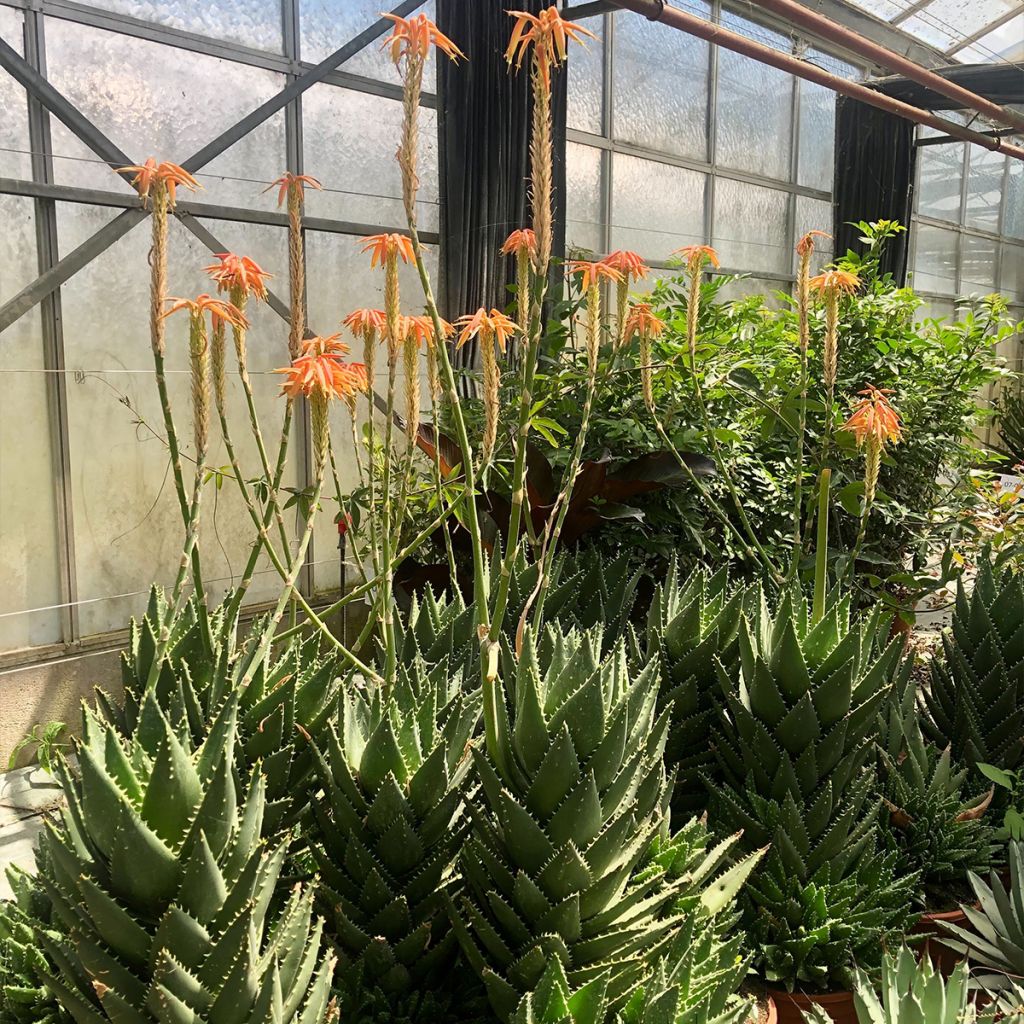

Aloe perfoliata (mitriformis)


Aloe perfoliata (mitriformis)


Aloe perfoliata (mitriformis)
Aloe perfoliata (mitriformis)
Aloe perfoliata
Perfoliate aloe
Satisfaction guaranteed
Sandrine C., 29/10/2022
Why not try an alternative variety in stock?
View all →This plant carries a 12 months recovery warranty
More information
We guarantee the quality of our plants for a full growing cycle, and will replace at our expense any plant that fails to recover under normal climatic and planting conditions.
From €5.90 for pickup delivery and €6.90 for home delivery
Express home delivery from €8.90.
Does this plant fit my garden?
Set up your Plantfit profile →
Description
Aloe perfoliata, formerly known as Aloe mitriformis, forms beautifully colourful rosette carpets in dry rocky areas exposed to intense sunlight. This perennial succulent plant develops stems that bend under the weight of the rosettes and root in different places. These rosettes have fleshy, triangular leaves with small non-prickly white teeth along the edges. They are adorned with warm and soft shades and come to life in late spring or early summer with parasol-shaped carmine red inflorescences that are incredibly nectar-rich. This aloe thrives in full sun, in a Mediterranean-style garden or in a large pot on a patio.
Aloe perfoliata is a botanical species in the Asphodelaceae family. It is native to the Southwest of South Africa (Western Cape), where it grows in rocky coastal and mountainous areas. Its frost resistance is estimated at -5 or -6°C (23 or 21.2°F) in dry soil. It is a succulent perennial plant of modest size, with a prostrate habit, reaching 30 to 40cm (12 to 16in) in height but capable of spreading over 1.5 to 2m² (2 to 7ft²). Each leaf rosette quickly elongates to form a leafy stem that bends and creeps under its own weight. Each rosette, facing towards the sky, is composed of thin, triangular, slightly incurved, pointed leaves, ranging in colour from bluish green to dark green. Under the effect of sun and drought, the edges of the leaves, as well as their undersides, develop shades of brick, pink to red, and even mauve tones. The aging leaves dry up and form a thick sheath around the creeping stem. Flowering occurs in summer, from June to August. The branched inflorescence, measuring 40 to 60cm (16 to 24in) in height, emerges from the heart of the rosette. It takes the form of a bouquet of long, carmine red tubular flowers arranged in an umbrella shape. The floral stem shifts away from the heart as new leaves appear. The flowers are popular with pollinating insects,
Highly resistant to salt spray and drought, Aloe perfoliata can be cultivated both in pots to decorate a patio or balcony, and in open ground, in a rock garden or on a dry bank. In a mild climate, or on the protected Atlantic coast, it can be acclimatised in open ground. It will enhance steep or rocky, well-drained terrain, or even the top of a dry-stone wall. Elsewhere, it can be planted in a wider than tall pot to fully appreciate its unique charm. For example, it can be combined with small agaves, echeverias, and delosperma in a collection of potted plants. You can plant low-growing, undemanding ground covers such as Missouri evening primrose, osteospermums, and felicia at its base, which will fill the space with their flowering and evergreen foliage, and hide the void left by a dead plant
About Agaves and Aloes
Aloes and agaves look alike but belong to two different botanical families, the Asphodelaceae and the Asparagaceae. The main difference between them lies in the fact that the rosettes of aloes flower for many years, while the flowering of a mature agave rosette marks the end of its life. In certain species of aloes, interfoliar buds give rise to new plants that cover the dried remains of the mother plant. In agaves, the central flower stalk develops from the terminal bud. In aloes, the flower buds arise between the leaves. Agaves are native to North America, while aloes are found only in the southern half of Africa and in the nearby islands of the Indian Ocean.
Report an error about the product description
Flowering
Foliage
Plant habit
Botanical data
Aloe
perfoliata
Aloeaceae
Perfoliate aloe
Aloe mitriformis
South Africa
Other Aloe
Planting and care
Like all succulent plants, aloes thrive in full sun and very well-drained, poor and dry soil. Aloe perfoliata is hardy down to -5 or -6°C (23 or 21.2°F) in very well-drained or even dry soil. It is easy to grow in a dry rockery with plenty of sunlight, an enriched gravel bed, or in pots. In wet regions during winter, a glass cover should be installed over the rosettes to protect them from combined rain and cold. Occasional watering is appreciated in summer (especially for potted plants). Fertiliser is not obligatory, although it does help the plant to look its best. Plants grown in pots should be overwintered frost-free in a very bright, but unheated, location (veranda, greenhouse).
Planting period
Intended location
Care
-
, onOrder confirmed
Reply from on Promesse de fleurs
Summer flowering perennials
Haven't found what you were looking for?
Hardiness is the lowest winter temperature a plant can endure without suffering serious damage or even dying. However, hardiness is affected by location (a sheltered area, such as a patio), protection (winter cover) and soil type (hardiness is improved by well-drained soil).

Photo Sharing Terms & Conditions
In order to encourage gardeners to interact and share their experiences, Promesse de fleurs offers various media enabling content to be uploaded onto its Site - in particular via the ‘Photo sharing’ module.
The User agrees to refrain from:
- Posting any content that is illegal, prejudicial, insulting, racist, inciteful to hatred, revisionist, contrary to public decency, that infringes on privacy or on the privacy rights of third parties, in particular the publicity rights of persons and goods, intellectual property rights, or the right to privacy.
- Submitting content on behalf of a third party;
- Impersonate the identity of a third party and/or publish any personal information about a third party;
In general, the User undertakes to refrain from any unethical behaviour.
All Content (in particular text, comments, files, images, photos, videos, creative works, etc.), which may be subject to property or intellectual property rights, image or other private rights, shall remain the property of the User, subject to the limited rights granted by the terms of the licence granted by Promesse de fleurs as stated below. Users are at liberty to publish or not to publish such Content on the Site, notably via the ‘Photo Sharing’ facility, and accept that this Content shall be made public and freely accessible, notably on the Internet.
Users further acknowledge, undertake to have ,and guarantee that they hold all necessary rights and permissions to publish such material on the Site, in particular with regard to the legislation in force pertaining to any privacy, property, intellectual property, image, or contractual rights, or rights of any other nature. By publishing such Content on the Site, Users acknowledge accepting full liability as publishers of the Content within the meaning of the law, and grant Promesse de fleurs, free of charge, an inclusive, worldwide licence for the said Content for the entire duration of its publication, including all reproduction, representation, up/downloading, displaying, performing, transmission, and storage rights.
Users also grant permission for their name to be linked to the Content and accept that this link may not always be made available.
By engaging in posting material, Users consent to their Content becoming automatically accessible on the Internet, in particular on other sites and/or blogs and/or web pages of the Promesse de fleurs site, including in particular social pages and the Promesse de fleurs catalogue.
Users may secure the removal of entrusted content free of charge by issuing a simple request via our contact form.
The flowering period indicated on our website applies to countries and regions located in USDA zone 8 (France, the United Kingdom, Ireland, the Netherlands, etc.)
It will vary according to where you live:
- In zones 9 to 10 (Italy, Spain, Greece, etc.), flowering will occur about 2 to 4 weeks earlier.
- In zones 6 to 7 (Germany, Poland, Slovenia, and lower mountainous regions), flowering will be delayed by 2 to 3 weeks.
- In zone 5 (Central Europe, Scandinavia), blooming will be delayed by 3 to 5 weeks.
In temperate climates, pruning of spring-flowering shrubs (forsythia, spireas, etc.) should be done just after flowering.
Pruning of summer-flowering shrubs (Indian Lilac, Perovskia, etc.) can be done in winter or spring.
In cold regions as well as with frost-sensitive plants, avoid pruning too early when severe frosts may still occur.
The planting period indicated on our website applies to countries and regions located in USDA zone 8 (France, United Kingdom, Ireland, Netherlands).
It will vary according to where you live:
- In Mediterranean zones (Marseille, Madrid, Milan, etc.), autumn and winter are the best planting periods.
- In continental zones (Strasbourg, Munich, Vienna, etc.), delay planting by 2 to 3 weeks in spring and bring it forward by 2 to 4 weeks in autumn.
- In mountainous regions (the Alps, Pyrenees, Carpathians, etc.), it is best to plant in late spring (May-June) or late summer (August-September).
The harvesting period indicated on our website applies to countries and regions in USDA zone 8 (France, England, Ireland, the Netherlands).
In colder areas (Scandinavia, Poland, Austria...) fruit and vegetable harvests are likely to be delayed by 3-4 weeks.
In warmer areas (Italy, Spain, Greece, etc.), harvesting will probably take place earlier, depending on weather conditions.
The sowing periods indicated on our website apply to countries and regions within USDA Zone 8 (France, UK, Ireland, Netherlands).
In colder areas (Scandinavia, Poland, Austria...), delay any outdoor sowing by 3-4 weeks, or sow under glass.
In warmer climes (Italy, Spain, Greece, etc.), bring outdoor sowing forward by a few weeks.




































